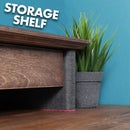Introduction: Punch Bag Wall Bracket Made From Scaffolding - Keep Fit at Home
A few months ago I made a wall bracket for a punch bag using scaffold pole and scaffold fittings. It proved quite popular and I got a few messages asking if I could tweak the design to use less scaffolding and if I could suggest where to buy the materials from. Well I teamed up with Evolution Power Tools, who sponsored this project, to tweak the design but also, Evolution Power Tools have put together a kit that includes the materials you need to make it. You can find the kit here: https://shop.evolutionpowertools.com/
Supplies
Materials included in the kit:
- 900mm Scaffold Pole
- Wall Plate
- Adjustable Tee
- Hook
- Swivel Flange
- End Cap
- 6x Coach Screws
- 6x Rawl Plugs
- Punch Bag & Gloves
Tools Needed:
- Evolution Saw
- Drill & Masonary Drill Bit
- 8mm Hex Key/Allen Key
- Spanner
Step 1: Cut the Scaffold Pole to Length
Included in the kit is a 900mm piece of scaffold pole. The first job is to cut this to length. Evolution Saws can cut through scaffold pole with ease so first mark 50cm on the pole and make your cut on the waste side of the line.
This one cut should leave you with 2 pieces of scaffold pole measuring 50cm and 40cm. These lengths don't have to be spot on.
Step 2: Mount the Scaffold Fittings
With the scaffold pole cut to length, now its time to assemble all the pieces together. First, loosen all the hex screws on the fittings using an 8mm hex key/Allen key so the scaffold pole can easily fit inside.
It's easier if you attach the adjustable tee fitting first to the end of the 50cm scaffold pole. Position it roughly 10cm in from the end of the pole for now and secure it in place by tightening the hex screw.
Now slide the 40cm scaffold pole into the bottom of the adjustable tee fitting. Tighten the hex screw to hold it in place.
The wall plate can be added next. This gets attached to the other end of the 50cm scaffold pole. Slide it onto the pole and make sure the pole isnt protruded out of the back of the wall plate. you want it slightly inset a little. Secure it in place by tightening the hex screw.
The last piece to add in this step is the swivel flange. This gets attached to the bottom of the diagonal 40cm scaffold pole. Make sure the pole is fully seating in the fitting and then secure it in place with the hex screw.
Step 3: Level the Fittings
At this stage you may notice that the fittings don't sit flush on a flat surface. If this is the case then they won't sit flush against the wall so you need to adjust the fitting to make them level. This is really easy to do.
Sit the bracket on a flat surface and then loose the hex screw on the adjustable tee fitting. The side that attaches to the 50cm scaffold pole is the one you want to loosen. It should slide down and level out the wall plate and swivel flange so they sit flush and level on the flat surface.
When its sitting level you can tighten the hex screw back up so you know it will sit flush on the wall.
Step 4: Drill the Wall
Now the bracket can be mounted on the wall. The height it needs to be mounted will depend on your height and what feels comfortable to you. Your best to get someone to hold the bracket in place for you so you can get a feel for where is best to mount it.
Once you're happy with the mounting position mark the wall through the holes in the wall plate and the swivel flange. These will be marks you need drill to add the rawl plugs and coach screws.
Using a masonry drill bit and a drill set to hammer mode drill where you marked for holes. You can use the dust left on the drill bit to check if you have drilled deep enough for the coach screws. With the holes drilled add a rawl plug to each hole. These will help hold the coach screws in place.
You may notice I have only drilled 2 holes for the wall plate, this is because I may be moving the bracket to a different position. So for now, I will just use 2 mounting points. It is recommended to use all 4 though.
Step 5: Mount on the Wall
The easiest way to mount the bracket on the wall is the first remove the swivel flange from the bottom of the bracket and mount that to the wall on its own first. This is so you can get both coach screws in place without the fitting being in the way.
Using a spanner, drive in the coach screws through the mounting holes on the swivel flange. One in the top and one in the bottom.
With the swivel flange mounted you can now slide the bottom of the diagonal 40cm scaffold pole back into the swivel flange then lift the bracket until the wall plate touches the wall. It should line up with the holes you drilled. If not you can loosen the hex screw and tweak the positioning of the poles and fittings until they line up.
When its sitting flat and lining up with the holes you can secure the wall plate in place with the 4 coach screws. one through each mounting hole.
At this stage the bracket feels nice and solid but don't forget to tighten the hex screw on the side of the swivel flange to make it fully secure.
Step 6: Add the Hook and End Cap
The last thing to do on this project is to add the hook fitting and the end cap. The hook slides onto the end of the horizontal 50cm scaffold pole. Secure it in place with the hex screw on top.
The end cap fits in the hole at the end of the 50cm scaffold pole. It should pot into place with a little persuasion. A hammer always helps.
With the end cap added, that completes this project. Now you can hang the punch on the hook and use it for your home work outs. Its a fantastic way to keep fit. When you're not using the punch bag you can always hang a hanging basket on the hook instead. It looks great and helps the bracket to blend in with the rest of the garden.

Participated in the
Backyard Contest













